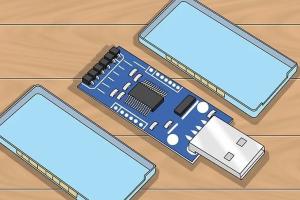6 Effective Solutions to Repair Your USB Flash Drive Easily

-
Quick Links:
- Understanding USB Flash Drives
- Common Issues with USB Flash Drives
- Method 1: Check Physical Connections
- Method 2: Use Disk Management
- Method 3: Run CHKDSK Command
- Method 4: Format the USB Drive
- Method 5: Use Data Recovery Software
- Method 6: Seek Professional Help
- Conclusion
- FAQs
Understanding USB Flash Drives
USB flash drives are portable storage devices that connect to your computer or other devices via a USB port. They are compact, easy to use, and have become a preferred method for data storage and transfer. Typically, USB drives range from 2GB to 2TB in capacity, making them versatile for various applications—be it storing documents, photos, or entire operating systems.
The Technology Behind USB Drives
USB flash drives use NAND flash memory, a type of non-volatile storage that retains data without power. This technology allows for rapid read and write speeds, contributing to the convenience and efficiency of USB drives. However, like all technology, they can encounter issues that may hinder their performance.
Common Issues with USB Flash Drives
USB drives can experience several problems, including:
- Drive Not Recognized: Often caused by connection issues or file system corruption.
- Corrupted Files: Data may become corrupted due to improper ejection or malware.
- Physical Damage: Bending or breaking the USB connector can lead to failure.
- Write Protection Errors: Sometimes, the drive may become write-protected, preventing data modification.
Method 1: Check Physical Connections
Before diving into complex solutions, always start by checking the physical connections of your USB flash drive. Here’s how:
- Inspect the USB connector for any debris or damage.
- Try connecting the USB drive to a different USB port.
- Test the drive on another computer to rule out device-specific issues.
- Consider using a different USB cable if applicable.
Method 2: Use Disk Management
If your USB drive is not recognized, it might not have a drive letter assigned. Here’s how to assign one:
- Right-click on the Windows Start menu and select Disk Management.
- Locate your USB drive in the list of volumes.
- If it’s shown as unallocated, right-click and choose New Simple Volume.
- Follow the wizard to assign a drive letter and format it if necessary.
Method 3: Run CHKDSK Command
CHKDSK (Check Disk) is a built-in Windows utility that scans for and repairs filesystem errors. To run CHKDSK:
- Open the Command Prompt as an administrator.
- Type
chkdsk E: /f /r(replace "E" with your USB drive letter). - Press Enter and allow the utility to fix any detected issues.
Method 4: Format the USB Drive
If your USB drive is still not functioning properly, formatting might be necessary. This will erase all data, so ensure you have backups:
- Open File Explorer and right-click on your USB drive.
- Select Format.
- Choose the file system (NTFS or FAT32) and click Start.
Method 5: Use Data Recovery Software
If you need to recover data from a malfunctioning USB drive, consider using data recovery software. Some popular options include:
- Recuva - Ideal for recovering deleted files.
- Stellar Data Recovery - Comprehensive recovery solutions.
- EaseUS Data Recovery Wizard - User-friendly interface for recovery.
Method 6: Seek Professional Help
If all else fails, consider reaching out to a data recovery professional. They have specialized tools and expertise that may recover your data, especially if the drive is physically damaged.
Conclusion
Repairing a USB flash drive can seem daunting, but following these methods can often restore functionality. Always remember to back up your important data to prevent loss in the future. If you encounter persistent issues, professional help is available.
FAQs
1. What should I do if my USB flash drive is not detected?
Check the physical connections, try a different port or computer, and use Disk Management to assign a drive letter.
2. Can I recover data from a corrupted USB drive?
Yes, you can use data recovery software to retrieve files from a corrupted USB drive, provided the drive is recognized by the computer.
3. Is formatting a USB drive safe?
Formatting a USB drive will erase all data. Ensure you have backups before proceeding.
4. How can I prevent my USB drive from getting corrupted?
Always safely eject your USB drive, avoid using it in different operating systems frequently, and keep it free of malware.
5. What is the lifespan of a USB flash drive?
The average lifespan of a USB flash drive is around 10 years, but it can vary based on usage and quality.
6. Can physical damage be repaired?
Physical damage is often challenging to repair. If the damage is severe, professional data recovery services may be necessary.
7. Why does my USB drive show as empty?
This could be due to file system corruption or accidental deletion. Running CHKDSK or using recovery software may help.
8. What does write protection mean?
Write protection prevents any changes to the data on the USB drive. You can disable it through the drive's settings or hardware switch.
9. Are there any free tools to repair USB drives?
Yes, tools like Disk Management, CHKDSK, and various data recovery software options offer free versions.
10. How can I securely dispose of a USB drive?
To securely dispose of a USB drive, consider using software to wipe the data completely or physically destroy the drive.
For further reading, here are some external resources:
Random Reads
- How to configure controls on pcsx2 emulator
- How to conference call on android
- How to repair a moth hole
- How to repair a lava lamp
- Disabling uninstalling chrome android
- How to edit windows registry
- How to wax a floor
- How to watch deleted youtube videos with url
- How to wipe a mac clean
- Power down ipad